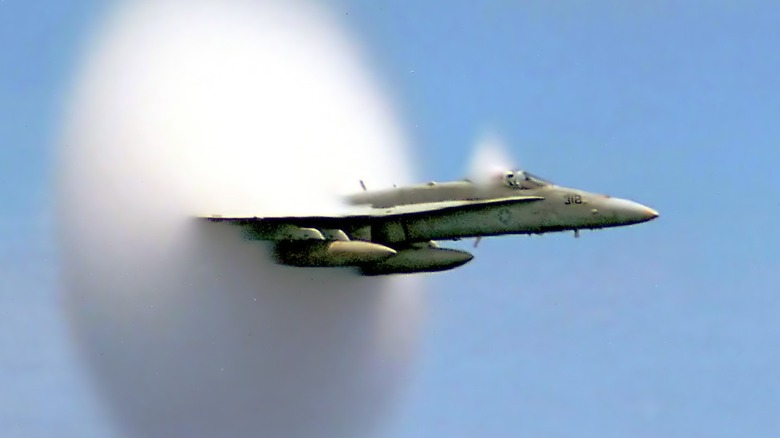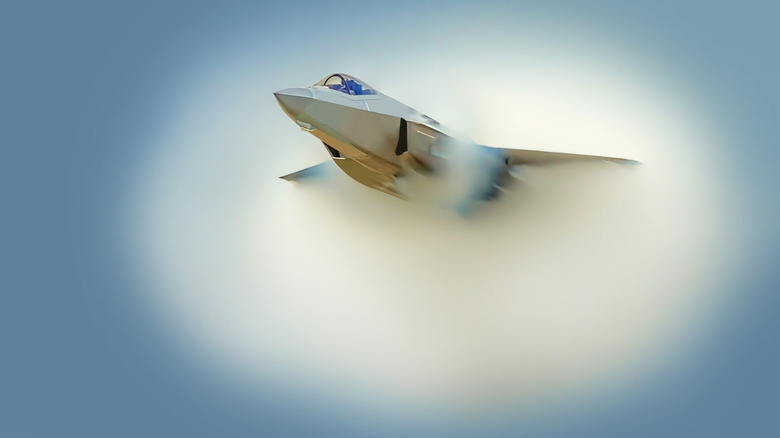When (And Why) Are Military Aircraft Allowed To Break The Sound Barrier?
The sound barrier is something many people have heard of, but few understand, as it's somewhat of a misnomer. The speed of sound is known as Mach 1 (767 mph), and when an object moves beyond this, it's called "breaking the sound barrier." This is also known as supersonic flight, a scientific term referring to moving faster than the speed of sound. When this happens, an aircraft reaches a point of increased aerodynamic drag, resulting in several changes, including a decrease in air temperature and air pressure.
This results in the formation of a white cloud (pictured) and a sonic boom. A sonic boom occurs when an aircraft goes supersonic, generating an enormous amount of sound energy, which sounds much like an explosion to the untrained ear. In Florida, whenever the Space Shuttle landed, Floridians became accustomed to the sound, which could vibrate glass panes and be heard hundreds of miles away, while visitors to the state likely had no clue what was happening. That's largely because sonic booms are rarely heard throughout the continental United States.
This is one of the reasons the Concorde didn't fly across the U.S., as it generated a sonic boom when traveling at supersonic speeds, which were only done over the ocean. Many military aircraft are capable of reaching supersonic speeds, but they rarely do so in the U.S., as this is largely restricted under most conditions. The only times that it's acceptable is over the ocean, at a training range far from a populated area, or under emergency conditions, (ideally with approval) including a time in 2023 when a D.C. Air National Guard F-16 went supersonic while pursuing an unresponsive Cessna private jet over D.C. airspace.
Historical and recent military sonic booms over the United States
The first aircraft to officially go supersonic was the Bell X-1, piloted by famed aviator Charles "Chuck" Yeager. He accomplished this feat on October 14, 1947, at an altitude of 45,000 feet. He dubbed his plane "Glamorous Glennis" (in honor of his wife), and he generated the first sonic boom with an aircraft launched from a modified Boeing B-29 Superfortress. Before long, other aircraft managed the same feat, and these days, supersonic jets are commonplace in many of the world's air forces.
While the Space Shuttle routinely generated sonic booms upon landing, there were several incidents of sonic booms occurring during emergencies. On 9/11, when it became clear that additional planes were possible threats, the military scrambled fighters in response. When one jet was deployed to protect Air Force One during the attack, it generated a sonic boom that was heard throughout the Dayton, Ohio area. Due to the ongoing crisis at the time, it's likely that people unfamiliar with the sound were concerned about potential targets in their immediate vicinity.
This is one of the main reasons supersonic flight hasn't been allowed over the United States and other populated areas, though this may change via a recent Executive Order by President Donald Trump. Sonic booms are incredibly disruptive, and when they're unexpected, they can cause panic. Because of this, when the Space Shuttle Atlantis was scheduled to land in 2013 and its flight path included areas in California, including northern Los Angeles, NASA issued a warning to inform the public about the potential for sonic booms in their area.

